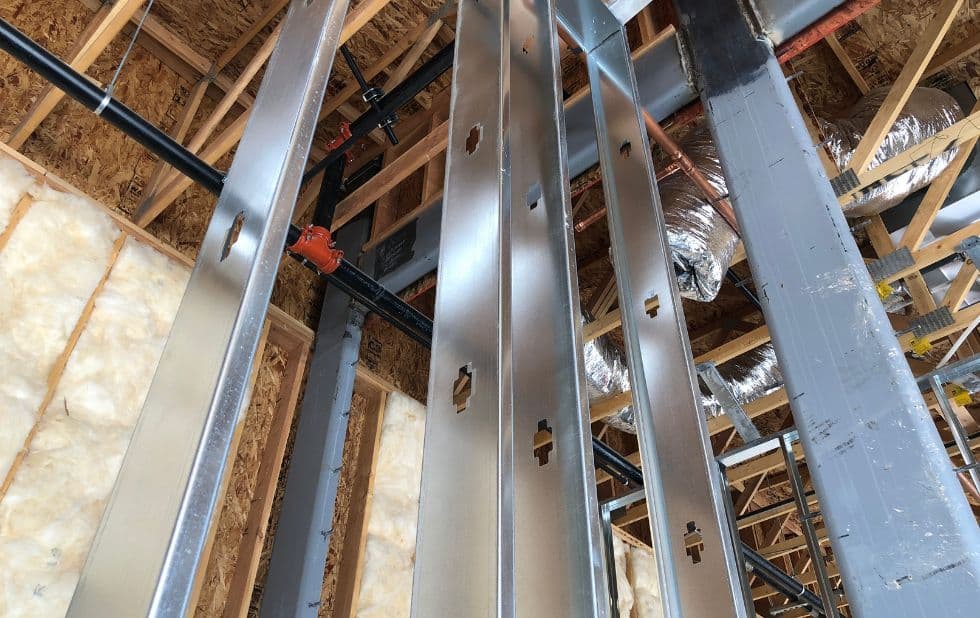When it comes to constructing walls for your home or commercial space, you’ll face two primary options: metal stud framing vs. wood framing. Each material offers unique advantages and disadvantages, making the choice a vital one for any building project. Let’s delve into a comprehensive comparison of these two framing methods to help you make an informed decision.
Strength and Durability:
Metal stud framing wins the battle for strength and durability. Its steel composition makes it significantly more resistant to bowing, warping, and cracking compared to wood. This translates to a building that’s better able to withstand natural disasters, heavy loads, and the test of time. Moreover, metal studs are impervious to termites and pests, eliminating the need for costly treatments and ensuring long-term structural integrity.
Fire Resistance:
Fire safety is paramount in any building project. Metal’s inherent fire-resistant properties make it the safer choice compared to wood. When exposed to flames, metal studs retain their shape and structural integrity much longer, providing additional time for occupants to evacuate. This enhanced safety makes metal framing a preferred option for buildings with strict fire regulations, such as high-rise structures and public spaces.
Dimensional Stability:
Metal studs exhibit superior dimensional stability compared to wood. They’re less prone to shrinkage, expansion, and warping due to changes in temperature and humidity. This ensures consistent dimensions throughout the structure, leading to a straighter, more accurate finished product. Additionally, the stability of metal eliminates the potential for nail pops, a common issue faced with wood framing.
Weight and Installation:
While wood studs are heavier and bulkier, their lightweight nature makes metal studs easier to transport and handle on-site. This results in reduced labor costs and faster installation times. Moreover, metal studs readily accept screws, simplifying the construction process and allowing for quicker completion of framing tasks.
Environmental Impact:
Metal framing boasts a lower environmental impact compared to wood. Steel is a recyclable material, minimizing waste and contributing to a more sustainable construction process. Additionally, metal framing requires fewer trees to be harvested, promoting sustainable forestry practices and reducing environmental degradation.
Acoustic Performance:
Metal stud walls, especially when combined with soundproof insulation, offer superior soundproofing capabilities compared to wood framing. This is due to the inherent rigidity of metal, which efficiently transmits less noise through the walls. This characteristic makes metal framing ideal for spaces requiring quiet environments, such as music studios, bedrooms, and conference rooms.
Cost Considerations:
While the initial cost of metal studs is generally higher than wood, the long-term benefits often outweigh the initial investment. The durability, fire resistance, and dimensional stability of metal framing translate to lower maintenance costs and a longer lifespan for the building. Additionally, metal framing can sometimes lead to faster construction times, further reducing overall project costs.
Material Availability:
Metal studs are readily available at most building supply stores, ensuring their accessibility for any construction project. While availability may vary depending on your location, their standardized nature makes it easier to find the specific sizes and profiles needed for your project.
Ease of Modification:
Wood surpasses metal in terms of ease of modification. Cutting, drilling, and nailing into wood are considerably easier than working with metal studs. This can be advantageous for projects requiring frequent modifications or adjustments to the framing layout.
Aesthetic Considerations:
Both materials offer aesthetic versatility. Metal studs can be easily covered with drywall or other finishing materials, creating a smooth, modern look. Wood can be exposed for a natural, rustic aesthetic, or painted to match the desired design scheme.
Conclusion:
Choosing between metal stud framing and wood framing depends on your project’s specific needs and priorities. While wood offers a lower initial cost and ease of modification, metal framing shines with its strength, durability, fire resistance, and dimensional stability. Additionally, metal’s environmental benefits and lower long-term maintenance costs make it an attractive option for many builders. Ultimately, the best choice will depend on your specific project requirements and budget.
By carefully assessing the pros and cons of each material, you can make an informed decision that ensures a strong, safe, and sustainable building for years to come.


